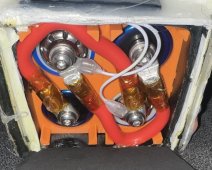dih dah dit !
Balance Obsession:
What this reasonable delta of 100mv or less, without worrying too much about it points out a problem that most are totally obsessed about achieving exact voltage parity when balancing. When that can mean squat from a practical standpoint.
Example: You perfectly top-balance 4 of your 280ah cells to within a .000001mv delta. Fine.
Now replace one of those 280ah cells with a 50ah cell. Can you top balance THAT? YES you can. But of course your bank is limited to that 50ah cell in operation, being the weakest link in capacity and it will be worked hard. I personally did this with 3 Winstons, and one smaller GBS cell just to prove a point to myself long ago.
Cells are not perfect in either capacity, nor internal resistance. Ideally they should all be the exact same. Top balance is JUST to make sure that no cell goes over the threshold from a *voltage* standpoint, not a capacity standpoint. Your bms-balancer doesn't actually know anything about it from a capacity standpoint, (in the case of purposely mismatched cells as above), merely voltage. It also says nothing about cell-health.
Take 4 pristine 280ah cells (just because they are popular) that are vintage fresh from the factory. Swap one out for some bloated piece of crap. Can you top-balance that to 0.00001mv delta perfection? Yes you can! Is it practical - no. But a trap here is that there is a sales demographic being targeted for voltage-parity balance obsession with proven questionable practices. Like balancing at 3.4v. Or "balance all the time". Lots of dongles you can hang on. All the while FOOLING the buyer into a false sense of balance, merely because they can obtain voltage-parity balance at low voltages below or just at the start of the upper charge knee with minute deltas.
So yeah, I can live with a 100mv disparity - as long as that is measured while ABOVE 3.4v/cell as long as the system has proved stable with relatively equal cells.
But stuff happens, degradation and aging are different too, so you don't totally abandon it. You look in on it from time to time. You don't give it to your neighbor.
Balance Obsession:
What this reasonable delta of 100mv or less, without worrying too much about it points out a problem that most are totally obsessed about achieving exact voltage parity when balancing. When that can mean squat from a practical standpoint.
Example: You perfectly top-balance 4 of your 280ah cells to within a .000001mv delta. Fine.
Now replace one of those 280ah cells with a 50ah cell. Can you top balance THAT? YES you can. But of course your bank is limited to that 50ah cell in operation, being the weakest link in capacity and it will be worked hard. I personally did this with 3 Winstons, and one smaller GBS cell just to prove a point to myself long ago.
Cells are not perfect in either capacity, nor internal resistance. Ideally they should all be the exact same. Top balance is JUST to make sure that no cell goes over the threshold from a *voltage* standpoint, not a capacity standpoint. Your bms-balancer doesn't actually know anything about it from a capacity standpoint, (in the case of purposely mismatched cells as above), merely voltage. It also says nothing about cell-health.
Take 4 pristine 280ah cells (just because they are popular) that are vintage fresh from the factory. Swap one out for some bloated piece of crap. Can you top-balance that to 0.00001mv delta perfection? Yes you can! Is it practical - no. But a trap here is that there is a sales demographic being targeted for voltage-parity balance obsession with proven questionable practices. Like balancing at 3.4v. Or "balance all the time". Lots of dongles you can hang on. All the while FOOLING the buyer into a false sense of balance, merely because they can obtain voltage-parity balance at low voltages below or just at the start of the upper charge knee with minute deltas.
So yeah, I can live with a 100mv disparity - as long as that is measured while ABOVE 3.4v/cell as long as the system has proved stable with relatively equal cells.
But stuff happens, degradation and aging are different too, so you don't totally abandon it. You look in on it from time to time. You don't give it to your neighbor.
Last edited:




